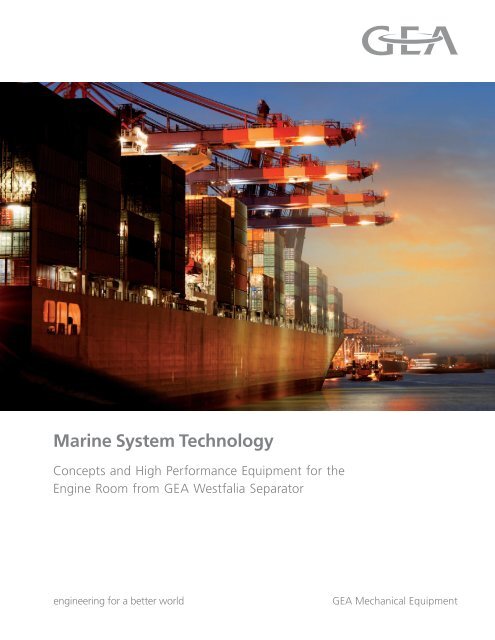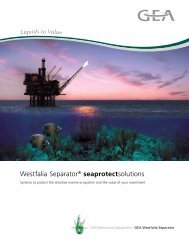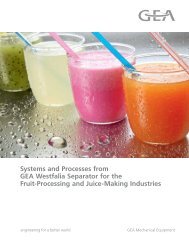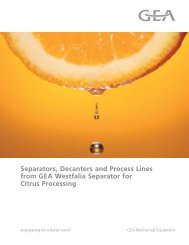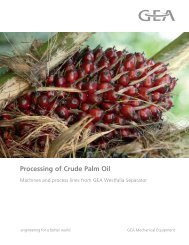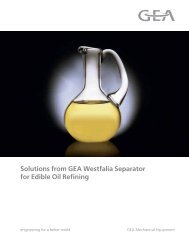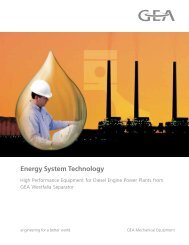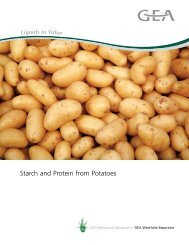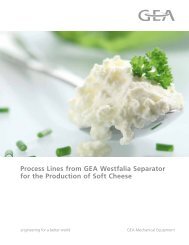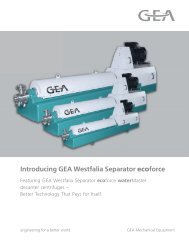GEA Westfalia Separator Marine Systems Technology brochure
GEA Westfalia Separator Marine Systems Technology brochure
GEA Westfalia Separator Marine Systems Technology brochure
You also want an ePaper? Increase the reach of your titles
YUMPU automatically turns print PDFs into web optimized ePapers that Google loves.
<strong>Marine</strong> System <strong>Technology</strong><br />
Concepts and High Performance Equipment for the<br />
Engine Room from <strong>GEA</strong> <strong>Westfalia</strong> <strong>Separator</strong><br />
engineering for a better world<br />
<strong>GEA</strong> Mechanical Equipment
Time for a New Generation<br />
Smart<br />
The new <strong>GEA</strong> <strong>Westfalia</strong> <strong>Separator</strong> eagleclass was<br />
developed by the technology leader in centrifugal<br />
separation technology. The innovative separator<br />
design and the new <strong>GEA</strong> <strong>Westfalia</strong> <strong>Separator</strong><br />
unitrolplus sensor system are setting new<br />
standards in energy, marine, oil field, industrial<br />
and environmental technology.<br />
Strong<br />
The strong g-force permits throughput<br />
capacities of up to 80 m 3 /h for the first time ever.<br />
<strong>GEA</strong> <strong>Westfalia</strong> <strong>Separator</strong> unitrolplus assures the<br />
highest separation efficiency of the different<br />
media such as fuel and lube oils, oily water,<br />
washing lye, etc.<br />
Reliable<br />
Compact, robust construction makes the<br />
<strong>GEA</strong> <strong>Westfalia</strong> <strong>Separator</strong> eagleclass particularly<br />
reliable and durable. A further feature is<br />
<strong>GEA</strong> <strong>Westfalia</strong> <strong>Separator</strong> serv&care – a proactive<br />
service concept from the original manufacturer.<br />
This combination ensures maximum availability<br />
and economy throughout the entire life cycle of<br />
the equipment.<br />
2<br />
<strong>GEA</strong> <strong>Westfalia</strong> <strong>Separator</strong>
Contents<br />
4 Overview Engine Room Concepts<br />
4 High Performance Equipment for the<br />
Engine Room<br />
6 Manual Cleaning <strong>Separator</strong>s<br />
6 <strong>GEA</strong> <strong>Westfalia</strong> <strong>Separator</strong> minimaXx ®<br />
7 Self-Cleaning <strong>Separator</strong>s<br />
8 Self-Cleaning <strong>Separator</strong><br />
with Centripetal Twin Pump<br />
9 Self-Cleaning <strong>Separator</strong>s<br />
9 <strong>GEA</strong> <strong>Westfalia</strong> <strong>Separator</strong> unitrolplus –<br />
Lube and Fuel Oil<br />
11 Diesel Oil Treatment<br />
11 Process Overview<br />
11 Manual Cleaning Solutions<br />
12 Self-Cleaning Solutions<br />
13 Heavy Fuel Oil Treatment<br />
13 Process Overview<br />
14 Plant Concepts with a System<br />
14 Parallel Operation<br />
16 Lube Oil Treatment<br />
16 Process Overview<br />
17 Plant Concepts for Efficient Operation<br />
18 Control Units<br />
18 Automatic Process Control –<br />
More Safety, More Comfort<br />
19 <strong>GEA</strong> <strong>Westfalia</strong> <strong>Separator</strong> minimaXx ® –<br />
Process Control for Every Requirement<br />
3<br />
20 Custom-Made System Solutions for the<br />
Engine Room<br />
20 <strong>Separator</strong> with Single Components<br />
21 CU Compact Unit – Flexible Modularization<br />
22 <strong>GEA</strong> <strong>Westfalia</strong> <strong>Separator</strong> centripack –<br />
<strong>GEA</strong> <strong>Westfalia</strong> <strong>Separator</strong><br />
Individual Modularization<br />
23 Sludge Treatment<br />
23 Process Overview<br />
24 System Concepts for the Future<br />
25 Economical Advantages – Ecological Merits<br />
26 Bilgewater Treatment<br />
26 Self-Cleaning Centrifugal System<br />
28 Technologies to Protect the Sensitive<br />
<strong>Marine</strong> Ecosystem<br />
29 Flexible Compact Unit Design<br />
30 <strong>GEA</strong> <strong>Westfalia</strong> <strong>Separator</strong> SafetyMaster<br />
32 Fuel Oil Conditioning System<br />
32 <strong>GEA</strong> <strong>Westfalia</strong> <strong>Separator</strong> ViscoBoosterUnits<br />
33 Complete System Between Service<br />
Tank and Engine<br />
34 Water Desalination System<br />
35 <strong>GEA</strong> <strong>Westfalia</strong> <strong>Separator</strong> SeaWaterDistiller<br />
36 <strong>GEA</strong> <strong>Westfalia</strong> <strong>Separator</strong> BallastMaster ultraV<br />
38 <strong>GEA</strong> <strong>Westfalia</strong> <strong>Separator</strong> serv&care –<br />
Proactive Service for Optimum<br />
Reliability on Board
High Performance Equipment<br />
for the Engine Room<br />
Overview of engine room concepts<br />
<strong>GEA</strong> <strong>Westfalia</strong> <strong>Separator</strong> offers leading<br />
technologies and individual systems for marine<br />
use. Be it system engineering from high quality<br />
work manship or unrivalled worldwide service<br />
– <strong>GEA</strong> <strong>Westfalia</strong> <strong>Separator</strong> provides systems to<br />
rely on.<br />
Product range overview<br />
• Fuel oil treatment<br />
• Fuel oil conditioning system<br />
• Lube oil treatment<br />
• Sludge treatment<br />
• Bilgewater treatment<br />
• Water desalination system<br />
• Hydraulic oil treatment plants<br />
• Ballast water treatment<br />
<strong>GEA</strong> <strong>Westfalia</strong> <strong>Separator</strong> supplies separation<br />
systems specifically designed for continuous<br />
operation under the roughest conditions. This<br />
gives you:<br />
• Optimum power output<br />
• Long service life for your engines<br />
• High environmental standards<br />
4<br />
<strong>GEA</strong> <strong>Westfalia</strong> <strong>Separator</strong><br />
1 Fuel oil service tank<br />
2 Fuel oil conditioning system<br />
3 Fuel oil setting tank<br />
1<br />
3<br />
5<br />
7<br />
2<br />
4<br />
6<br />
4 Fuel oil treatment<br />
5 Fuel oil sludge tank<br />
6 Sludge treatment
8<br />
9<br />
7 Lube oil sludge tank<br />
8 Lube oil treatment M.E.<br />
9 Lube oil treatment A.E.<br />
12<br />
14<br />
10 Water desalination system<br />
11 Bilgewater treatment<br />
12 Bilgewater tank<br />
10<br />
11<br />
13 Ballast water treatment<br />
14 Water tank<br />
5<br />
<strong>GEA</strong> <strong>Westfalia</strong> <strong>Separator</strong><br />
13
<strong>GEA</strong> <strong>Westfalia</strong> <strong>Separator</strong> minimaXx ®<br />
Manual cleaning separators<br />
Manual cleaning separators with a solid wall bowl<br />
and a single centripetal pump are used mostly<br />
for the treatment of diesel oil and lube oil on<br />
smaller ships. They are suitable for clarifying or<br />
purifying oils with a low solids content of up to<br />
0.1 percent by vol.<br />
The clean oil is discharged from the bowl under<br />
pressure by means of a centripetal pump. The<br />
separated solids slide down the underside of the<br />
disc into the solids holding space which must be<br />
emptied periodically by hand.<br />
Benefits<br />
• Suitable for both clarifying and purifying<br />
• Highly concentrated solids<br />
• Simple construction<br />
• Versatility of application<br />
Filling water<br />
6<br />
<strong>GEA</strong> <strong>Westfalia</strong> <strong>Separator</strong><br />
Dirty oil feed<br />
Dirty water discharge<br />
Clean oil discharge<br />
Bowl cross-section of a manual<br />
cleaning mineral oil separator<br />
with pressure discharge of the<br />
clean oil by centripetal pump
Self-cleaning separators<br />
Self-cleaning separators with a disc bowl, single<br />
centripetal pump and automatic solids ejection<br />
are used where the percentage of solids in the<br />
oil is too high for manual cleaning. These are<br />
used mainly for the clarification and purification<br />
of oils such as gas oil, diesel oil and lube oil.<br />
Self-cleaning separators discharge solid matter<br />
automatically while the separator is running.<br />
This avoids the need to shut down the separator<br />
for frequent cleaning.<br />
Self-cleaning separators operate continuously.<br />
Total ejections are used with a self-cleaning<br />
effect on the disc stack. Labor-intensive and costly<br />
measures to clean the discs using CIP systems are<br />
not necessary. Optimum separation efficiency<br />
over long operating times is ensured. Maintenance<br />
work is not required until up to 8,000 operating<br />
hours (i.e., approx. only once a year).<br />
The clean oil is conveyed to the discharge under<br />
pressure by means of a centripetal pump. The<br />
separated water flows under gravity via a<br />
regulating ring to the discharge.<br />
Benefits<br />
• Automatic operation<br />
• Continuous operating mode<br />
• Self-cleaning effect of the bowl<br />
without CIP systems<br />
• Highly concentrated solids<br />
• High separation efficiency<br />
• Can be used as clarifier and purifier<br />
• Closed discharge of the light phase<br />
under pressure by centripetal pump<br />
• Low noise level<br />
• Belt drive gives you less wear and tear<br />
Filling and<br />
displacement water<br />
7<br />
Dirty oil feed<br />
Dirty water discharge<br />
Solids discharge<br />
Operating water discharge<br />
<strong>GEA</strong> <strong>Westfalia</strong> <strong>Separator</strong><br />
Clean oil discharge<br />
Bowl cross section of a<br />
self-cleaning mineral oil separator<br />
with solid wall disc bowl
Self-Cleaning <strong>Separator</strong><br />
with Centripetal Twin Pump<br />
Self-cleaning separators with a disc bowl and<br />
an automatic solids ejection are used where the<br />
percentage of solids in the oil is too high<br />
for manual cleaning. These are used mainly<br />
for the clarification and purification of<br />
oils such as gas oil, diesel oil and lube oil.<br />
Self-cleaning separators discharge solid<br />
matter automatically while the separator<br />
is running. This avoids the need to shut down<br />
the separator for frequent cleaning.<br />
Self-cleaning separators operate continuously.<br />
Solids ejection occurs either by total or<br />
partial discharges, or a combination of both.<br />
In the case of the total ejection and the<br />
combination of total and partial ejections, there<br />
is additional self-cleaning of the disc stack.<br />
Labor-intensive and costly measures to clean<br />
the discs using CIP systems are not necessary.<br />
Optimum separation efficiency over long<br />
operating times is ensured.<br />
Maintenance work is required<br />
only after 8,000 to 16,000<br />
operating hours.<br />
The clean oil and the<br />
separated water are<br />
conveyed to the discharge<br />
under pressure by<br />
a centripetal<br />
twin pump.<br />
Bowl cross-section of a<br />
self-cleaning mineral oil<br />
separator with disc bowl<br />
8<br />
<strong>GEA</strong> <strong>Westfalia</strong> <strong>Separator</strong><br />
Benefits<br />
• Automatic operation<br />
• Continuous operating mode<br />
• Self-cleaning effect of the bowl<br />
without CIP systems<br />
• Highly concentrated solids<br />
• High separation efficiency<br />
• Can be used as clarifier and purifier<br />
• Closed discharge of the light phase<br />
under pressure by centripetal pump<br />
• Low noise level<br />
• Belt drive gives you less wear and tear<br />
Filling and<br />
displacement<br />
water<br />
Clean oil<br />
discharge<br />
Centripetal<br />
twin pump<br />
Dirty water<br />
discharge<br />
Operating water<br />
discharge<br />
Dirty oil<br />
feed<br />
Solids discharge
<strong>GEA</strong> <strong>Westfalia</strong> <strong>Separator</strong> unitrolplus –<br />
Lube and Fuel Oil WMS / SMS in Single Stage<br />
Self-cleaning separators<br />
Modern lube and fuel oil treatment plants from<br />
<strong>GEA</strong> <strong>Westfalia</strong> <strong>Separator</strong> provide easy handling<br />
and optimum separating efficiency in difficult<br />
situations. The heart of these plants is a new<br />
generation of self-cleaning mineral oil separators<br />
with the unitrolplus. These separators operate<br />
without regulating rings and can be applied for<br />
a wide range of lube and fuel oils with a specific<br />
density up to 1.01 kg / l.<br />
The essential features of these separators are both<br />
the continuous monitoring of the oil for water<br />
and the continuous monitoring of the solids<br />
holding space for optimum solids filling in<br />
one stage. Automatic monitoring means that<br />
regulating rings are unnecessary and operating<br />
errors caused through manual adjustment<br />
are eliminated.<br />
The water content of the oil is checked<br />
continuously using the Water Monitoring System<br />
(WMS). The water in the oil is separated out<br />
and discharged. The Sludge Space Monitoring<br />
System (SMS) checks the solids space for<br />
separated foreign matter such as cat fines, sand,<br />
abrasives and rust.<br />
The oil is displaced prior to a bowl ejection.<br />
The precisely defined displacement<br />
volume minimizes oil losses. A further<br />
innovative feature of these separators<br />
is the bowl’s new hydraulic system<br />
(<strong>GEA</strong> <strong>Westfalia</strong> <strong>Separator</strong> hydrostop). Extremely<br />
short ejection times with the maximum outlet<br />
diameter provide for highly concentrated solids.<br />
Further disposal measures are simplified,<br />
disposal costs reduced and environmental<br />
considerations fully taken into account. During<br />
total ejections the disc stack is also cleaned.<br />
Work and cost intensive measures for cleaning<br />
the disc stack by CIP systems are not necessary.<br />
This ensures optimum separating efficiency<br />
over a long period of operation. Maintenance<br />
work is required only after 8,000 to 16,000<br />
operating hours.<br />
Just a few basic models are sufficient to cover all<br />
capacity ranges. This makes spare parts storage<br />
and servicing very economical.<br />
Filling and<br />
displacement<br />
water<br />
9<br />
<strong>GEA</strong> <strong>Westfalia</strong> <strong>Separator</strong><br />
Clean oil<br />
discharge<br />
<strong>GEA</strong> <strong>Westfalia</strong> <strong>Separator</strong><br />
unitrolplus<br />
Dirty water<br />
discharge<br />
Solids<br />
Operating water<br />
discharge<br />
Dirty oil feed<br />
discharge
Benefits<br />
• <strong>GEA</strong> <strong>Westfalia</strong> <strong>Separator</strong> unitrolplus –<br />
a new sensor system for automatic<br />
monitoring and control for water and<br />
solids content monitoring<br />
• Reliable treatment of particularly heavy<br />
and severely contaminated fuels<br />
• Self-thinking system – ideal also for<br />
the unmanned engine room<br />
• Treatment of fuel oils up to 1.01 kg / l<br />
• Lube oil treatment of 2-stroke cross<br />
head and 4-stroke trunk piston engine<br />
• Regulating rings are not required<br />
• Automatic adjustment as clarifier or purifier<br />
• High separation efficiency even in<br />
critical situations<br />
• Automatic bowl ejection<br />
• Highly concentrated solids<br />
• Continuous processing<br />
• Self-cleaning effect of the bowl and<br />
the disc stack by total ejection<br />
• Versatility of application<br />
• Safe operation<br />
• Belt drive gives you less wear and tear<br />
• Low noise level
1<br />
Service tank<br />
Fuel oil<br />
treatment plant<br />
with centrifugal<br />
separator<br />
Pump system<br />
Settling tank<br />
Pump system<br />
Bunker tank<br />
2<br />
6<br />
4<br />
Utilities<br />
Sludge<br />
3<br />
5<br />
Diesel Oil Treatment<br />
Process Overview<br />
Centrifuges are essential for the efficient control<br />
and removal of solids and water from fuel oils<br />
in fuel oil safety treatment systems. They will<br />
continue to be so in the future.<br />
Efficient treatment protects the diesel engine<br />
from wear to important components such as<br />
cylinder liners, pistons, piston rings and the<br />
injection system.<br />
Manual Cleaning<br />
Solutions<br />
This Pipe Installation Diagram (PID) shows<br />
examples of manual cleaning centrifugal systems<br />
for diesel oil treatment.<br />
1 Dirty oil feed<br />
2 Strainer<br />
3 Feed pump<br />
4 Manual cleaning<br />
separator<br />
Piping and installation system<br />
for marine diesel oil treatment<br />
system with manual cleaning<br />
separator without heater<br />
5 Clean oil discharge<br />
6 Dirty water discharge
Self-Cleaning Solutions<br />
Diesel oil treatment<br />
This Pipe Installation Diagram (PID) shows<br />
examples of self-cleaning centrifugal systems<br />
for diesel oil treatment.<br />
1<br />
9<br />
10<br />
2<br />
4<br />
3<br />
13 14 15<br />
12<br />
<strong>GEA</strong> <strong>Westfalia</strong> <strong>Separator</strong><br />
11<br />
5<br />
7<br />
6<br />
8<br />
12<br />
Piping and installation<br />
system for marine<br />
diesel oil treatment<br />
system with selfcleaning<br />
separator<br />
with electric heater<br />
1 Dirty oil feed<br />
2 Strainer<br />
3 Feed pump<br />
4 Preheater<br />
5 Regulating valve<br />
6 Steam<br />
7 Steam trap<br />
8 Condensate<br />
9 Dirty oil return<br />
10 Operating water<br />
11 Self-cleaning separator<br />
12 Clean oil discharge<br />
13 Dirty water discharge<br />
14 Operating water discharge<br />
15 Solids discharge
Heavy Fuel Oil Treatment<br />
Process Overview<br />
Centrifuges are essential for the efficient control<br />
and removal of solids and water from fuel oils<br />
in fuel oil safety treatment systems. They will<br />
continue to be so in the future.<br />
Low-grade fuels from different refining<br />
processes, such as atmospheric or vacuum<br />
distillation, as well as from conversion plants,<br />
such as catalytic cracker or the Visbreaker<br />
process, must be purified efficiently, too.<br />
This treatment protects the diesel engine from<br />
wear to important components such as cylinder<br />
liners, pistons, piston rings and the injection<br />
system. The whole plant concept for fuel oil<br />
treatment is rounded off with <strong>GEA</strong> <strong>Westfalia</strong><br />
<strong>Separator</strong> ViscoBoosterUnits.<br />
13<br />
Fuel oil<br />
conditioning<br />
system<br />
Service tank<br />
Fuel oil<br />
treatment plant<br />
with centrifugal<br />
separator<br />
Pump system<br />
Settling tank<br />
Pump system<br />
Bunker tank<br />
<strong>GEA</strong> <strong>Westfalia</strong> <strong>Separator</strong><br />
Utilities<br />
Sludge<br />
Single-stage treatment plant<br />
for fuel oil with separator with<br />
<strong>GEA</strong> <strong>Westfalia</strong> <strong>Separator</strong> unitrolplus
Plant Concepts with a System<br />
Under normal circumstances, <strong>GEA</strong> <strong>Westfalia</strong><br />
<strong>Separator</strong> recommends single-stage treatment<br />
for heavy fuel oils.<br />
High efficiency of separation with the <strong>GEA</strong><br />
<strong>Westfalia</strong> <strong>Separator</strong> unitrolplus WMS/SMS<br />
in a single-stage process ensures low wear<br />
on the engine. The high reliability and long<br />
service intervals ensure low operating costs<br />
1<br />
15<br />
2<br />
1 Steam<br />
2 Strainer<br />
3 Regulating valve<br />
4 Preheater<br />
14<br />
Parallel Operation (High Water Content)<br />
Heavy fuel oil treatment<br />
4<br />
3<br />
5 Dirty oil return<br />
6 Clean oil discharge<br />
7 Self-cleaning separator<br />
8 Operating water<br />
A stand-by centrifuge operating in parallel is<br />
recommended in emergencies when the water<br />
content in the fuel is greater than 10 percent<br />
by volume.<br />
The effective throughput of each machine should<br />
be reduced to 50 percent. Splitting the feed<br />
across two machines and effectively doubling<br />
the dwell time of the fuel in the centrifuges<br />
11<br />
12<br />
and continuous, unattended automatic<br />
operation for months. The stand-by centrifuge<br />
can be saved for occasional use in abnormal<br />
conditions – for example, during increased<br />
solids loading in heavy seas. It can also be<br />
used for occasional topping-up of the diesel<br />
oil day tank. An additional separator for<br />
diesel oil treatment is not necessary.<br />
5<br />
8<br />
7<br />
13<br />
9 Dirty water discharge<br />
10 Solids discharge<br />
11 Feed pump<br />
12 Filter<br />
9 10<br />
13 Dirty oil feed<br />
14 Steam trap<br />
15 Condensate<br />
allows the machines to remove the excess water<br />
effectively and quickly.<br />
This provides the following benefits:<br />
• Automatic total ejection of both centrifuges<br />
with optimally filled solids holding space<br />
• Longer intervals between solids ejections<br />
• Low water consumption<br />
• Reduced sludge tank loading<br />
• Lower disposal costs<br />
6
1 2<br />
1 Condensate<br />
2 Steam<br />
3<br />
3<br />
15<br />
3 Strainer<br />
4 Regulating valve<br />
5 Preheater<br />
15<br />
4<br />
4<br />
5<br />
5<br />
13<br />
13<br />
6 Dirty oil feed<br />
7 Dirty oil return<br />
8 Operating water<br />
9 Self-cleaning separator<br />
10 Clean oil discharge<br />
14<br />
14<br />
11 Dirty water discharge<br />
12 Solids discharge<br />
13 Feed pump<br />
14 Filter<br />
15 Steam trap<br />
15<br />
6 7 8<br />
<strong>GEA</strong> <strong>Westfalia</strong> <strong>Separator</strong><br />
9<br />
9<br />
11<br />
11<br />
12<br />
12<br />
10<br />
Fuel oil treatment plant with<br />
<strong>GEA</strong> <strong>Westfalia</strong> <strong>Separator</strong> unitrolplus<br />
and activated stand-by separator<br />
for parallel operation.
Lube Oil Treatment<br />
Process Overview<br />
Lube oil tank<br />
Utilities<br />
Sludge<br />
Schematic illustration of a lube oil treatment<br />
plant with manual cleaning separator.<br />
Lube oil<br />
treatment plant<br />
with centrifugal<br />
separator<br />
Pump system<br />
16<br />
<strong>GEA</strong> <strong>Westfalia</strong> <strong>Separator</strong><br />
Centrifugal separators are the most widespread<br />
method of lube oil treatment. The separator is<br />
located in a by-pass loop within the lube oil<br />
treatment system.
Plant Concepts for<br />
Efficient Operation<br />
Self-cleaning mineral oil centrifuges are chiefly<br />
used for the purification and dewatering of lube<br />
oils, especially when there is a requirement for<br />
24-hour, unattended operation.<br />
9<br />
1 2<br />
4<br />
3<br />
12 13<br />
11<br />
7<br />
5<br />
All <strong>GEA</strong> <strong>Westfalia</strong> <strong>Separator</strong> marine separators<br />
for the treatment of fuel and lube oil have<br />
identical design features allowing the use<br />
of common components. This simplifies both<br />
management and maintenance.<br />
17<br />
6<br />
8<br />
10<br />
<strong>GEA</strong> <strong>Westfalia</strong> <strong>Separator</strong><br />
1 Dirty oil feed<br />
2 Strainer<br />
3 Feed pump<br />
4 Pre-heater<br />
5 Regulating valve<br />
6 Steam<br />
7 Steam trap<br />
8 Condensate<br />
9 Operating water<br />
10 Clean oil discharge<br />
11 Self-cleaning separator<br />
12 Dirty water discharge<br />
13 Solids discharge<br />
Schematic illustration of a<br />
lube oil treatment plant with<br />
self-cleaning separator.
Automatic Process Control –<br />
More Safety, More Comfort<br />
Control units<br />
For <strong>GEA</strong> <strong>Westfalia</strong> <strong>Separator</strong> unitrolplus and<br />
centripetal twin pump system.<br />
Display with<br />
backlighting<br />
and 4 lines<br />
Keys F1 – F4<br />
Soft keypad,<br />
screen<br />
dependent<br />
Status LEDs<br />
Keys 1 – 0,<br />
Function keypad<br />
with fixed allocation<br />
Modern control and monitoring systems, using<br />
the latest PLC modules, ensure a high degree of<br />
operating safety and user comfort.<br />
They perform automatic control of the<br />
ejection cycles and monitoring of the selfcleaning<br />
separators. The ejection programs<br />
are preselectable. Partial or total ejections<br />
are initiated in adjustable, periodic intervals<br />
with prior displacement of the oil from<br />
the bowl.<br />
The standard control unit is designed for<br />
unattended operation of a separator.<br />
18<br />
<strong>GEA</strong> <strong>Westfalia</strong> <strong>Separator</strong><br />
D10 with<br />
text display<br />
E40 with graphic display<br />
and Profibus DP<br />
Easy handling by<br />
Micro Memory Card<br />
which stores setting<br />
and history data for<br />
D10 and E40.
<strong>GEA</strong> <strong>Westfalia</strong> <strong>Separator</strong> minimaXx ® –<br />
Process Control for Every Requirement<br />
1<br />
2<br />
3<br />
4<br />
5<br />
Motorstarter box<br />
Motorstarter separator<br />
Motorstarter feed pump<br />
OMB 220<br />
Overflow monitoring box<br />
Water seal broken alarm<br />
Control unit MC-1<br />
Motorstarter separator<br />
Motorstarter feed pump<br />
Flow monitoring FAH<br />
Control unit CC-1<br />
Motorstarter separator<br />
Motorstarter feed pump<br />
Flow monitoring FAH<br />
Temperature monitoring TAL / TAH<br />
Preheater interlocking<br />
Control unit CD-1<br />
Control and monitoring<br />
system for self-cleaning<br />
<strong>GEA</strong> <strong>Westfalia</strong> <strong>Separator</strong><br />
minimaXx ® separator.<br />
Motorstarter separator<br />
Motorstarter feed pump<br />
Flow monitoring FAH<br />
Flow monitoring FAL<br />
Clean oil outlet<br />
Temperature monitoring TAL / TAH<br />
Preheater interlocking<br />
Sludge pump control<br />
D10<br />
19<br />
1<br />
2<br />
3<br />
4<br />
5<br />
<strong>GEA</strong> <strong>Westfalia</strong> <strong>Separator</strong>
Custom-Made System Solutions<br />
for the Engine Room<br />
Flexible systems<br />
Design engineers have to be flexible with the<br />
planning of an engine room.<br />
<strong>Separator</strong>s with single components, modular<br />
compact units or individually installed<br />
<strong>GEA</strong> <strong>Westfalia</strong> <strong>Separator</strong> centripack systems<br />
give customers flexible options designed<br />
precisely to meet needs.<br />
1<br />
2<br />
3<br />
<strong>Separator</strong> with single components<br />
No modularization<br />
CU – Compact Unit<br />
Flexible modularization<br />
CP – <strong>GEA</strong> <strong>Westfalia</strong> <strong>Separator</strong> centripack<br />
Individual modularization<br />
1 2 3<br />
<strong>Separator</strong> with Single Components<br />
When planning the detail engineering of an<br />
engine room, design engineers need to construct<br />
plants precisely to meet their customers’ needs.<br />
Examples of elements that can be ordered separately<br />
Operating and displacement water valve<br />
<strong>GEA</strong> <strong>Westfalia</strong> <strong>Separator</strong> helps its customers<br />
develop individual systems by making all<br />
components available separately. This way<br />
systems can be adapted and built to the special<br />
needs that may apply.<br />
Steam trap<br />
Pre-heater<br />
Feed pump Pre-strainer 3 / 2 way valve Strainer Safety valve Regulating<br />
valve<br />
20<br />
<strong>GEA</strong> <strong>Westfalia</strong> <strong>Separator</strong>
CU Compact Unit –<br />
Flexible Modularization<br />
Flexible systems<br />
In addition to the detailed engineering of single<br />
components, there is the need for simple block<br />
engineering. CU compact units provide a<br />
modular design to meet this need.<br />
The modular CU compact units offer<br />
the opportunity to use flexible, low<br />
cost modules. All units are mounted<br />
on bases that can be connected easily, even in<br />
confined areas.<br />
21<br />
<strong>GEA</strong> <strong>Westfalia</strong> <strong>Separator</strong>
<strong>GEA</strong> <strong>Westfalia</strong> <strong>Separator</strong> centripack –<br />
Individual Modularization<br />
The centripack is a compact, self-contained<br />
treatment plant package system, ready for<br />
connection. All elements necessary for safe and<br />
efficient oil treatment are mounted in a spacesaving<br />
arrangement on a sturdy foundation<br />
frame. These include separators, motors, pumps,<br />
pre-strainer, alarm system and a control and<br />
monitoring system.<br />
The discharge pipes for solids and water as well<br />
as the frame drain pipe are led through the<br />
foundation frame.<br />
The design makes installation possible in corners<br />
or against walls, saving space. It is also possible<br />
to install several modules side-by-side to form a<br />
22<br />
<strong>GEA</strong> <strong>Westfalia</strong> <strong>Separator</strong><br />
complete plant. The centripack is completely<br />
assembled and function tested by <strong>GEA</strong> <strong>Westfalia</strong><br />
<strong>Separator</strong>. Faulty installation of single operating<br />
components on site is thus eliminated. The<br />
unified design also saves money and makes<br />
maintenance easier.<br />
The centripack is available with self-cleaning<br />
separators including control and monitoring<br />
equipment for unmanned operation, or with<br />
manual cleaning separators.<br />
The centripack modules are available with one<br />
to five separators.<br />
<strong>GEA</strong> <strong>Westfalia</strong> <strong>Separator</strong> centripack –<br />
complete ready-to-connect module for<br />
the treatment of fuel oil
Sludge Treatment<br />
Process Overview<br />
The trend towards burning higher viscosity and<br />
higher density fuel oils, together with the<br />
increasingly common usage of residuals<br />
as the fuel for medium speed diesel<br />
engines, means that the amount of sludge<br />
being created from both fuel and lube oil<br />
systems is increasing.<br />
Electrical energy<br />
Heating energy<br />
Operating water<br />
Settling tank Lube oil separator<br />
23<br />
<strong>GEA</strong> <strong>Westfalia</strong> <strong>Separator</strong><br />
Water<br />
Concentrated<br />
sludge<br />
Fuel oil separator Lube oil filter<br />
Fuel oil filter<br />
Diesel oil separator<br />
Settling tank / Boiler plant<br />
Recovered oil<br />
Sludge treatment plant with<br />
centrifugal separator<br />
Fuel oil sludge tank Lube oil sludge tank<br />
Disposal e.g.<br />
incinerator<br />
Bilgewater<br />
system
1<br />
5<br />
6<br />
8<br />
System Concepts for the Future<br />
The sludge is pumped from the sludge tank by<br />
an eccentric screw pump and is fed via a heater<br />
to the centrifugal separator.<br />
The sludge components of water, oil and solids<br />
are separated in the separator by centrifugal<br />
force. The recovered oil and water is discharged<br />
under pressure by centripetal pumps.<br />
The concentrated sludge is discharged<br />
intermittently via the sludge transfer unit<br />
2<br />
4<br />
1 Steam<br />
2 Regulating valve<br />
3 Pre-heater<br />
4 Steam trap<br />
7<br />
3<br />
5 Condensate<br />
6 Feed pump<br />
7 Filter<br />
8 Oil sludge feed<br />
16<br />
9 Dirty oil return<br />
10 Operating water<br />
11 Centrifugal separator<br />
12 Clean oil discharge<br />
24<br />
<strong>GEA</strong> <strong>Westfalia</strong> <strong>Separator</strong><br />
into a heated sedimentation tank where final<br />
concentration takes place. Excess water and oil<br />
is allowed to overflow back to the sludge tank.<br />
The concentrated sludge is pumped from the<br />
unit automatically by a solids discharge pump<br />
controlled by a level switch.<br />
A microprocessor-based control cabinet<br />
supervises and controls the complete<br />
concentration process.<br />
9<br />
10<br />
13<br />
17<br />
18<br />
13 Vibration monitoring<br />
14 Dirty water discharge<br />
15 Sludge transfer unit<br />
14<br />
11<br />
15<br />
12<br />
16 Sludge concentration<br />
unit<br />
17 Oily water<br />
18 Concentrated sludge
120<br />
100<br />
80<br />
60<br />
40<br />
20<br />
0<br />
Economical Advantages – Ecological Merits<br />
Sludge treatment<br />
Oily sludge, mainly consisting of oil, water<br />
and solids, can amount to 2.5 percent of the<br />
marine fuels consumed. Indeed, many port<br />
authorities use this figure when carrying out<br />
ship inspections.<br />
With increasing environmental awareness as<br />
well as strict regulations and controls, most<br />
operators dispose of this sludge by incineration<br />
or by shoreside disposal using contract<br />
companies. In either case, sludge disposal is<br />
becoming an expensive problem for ship owners.<br />
Our sludge treatment plants incorporate a<br />
specially designed centrifugal separator capable<br />
of reducing the volume of sludge for disposal by<br />
up to 90 percent. In addition, fuel oil is recovered<br />
for re-use and recovered lube oil can be used as<br />
boiler fuel.<br />
Benefits<br />
• Saves up to 90 percent disposal costs<br />
• Recovers valuable fuel oil<br />
• Unburdens the bilgewater system<br />
from oil residues<br />
• Protects our sensitive marine ecosystem<br />
Treatment system for oily and watery<br />
sludge with self-cleaning centrifugal<br />
separator to reduce the disposal costs<br />
Oily sludge<br />
feed<br />
25<br />
<strong>GEA</strong> <strong>Westfalia</strong> <strong>Separator</strong><br />
Filling and displacement water<br />
Separation results, sludge treatment MV Fantasy<br />
Portion<br />
120<br />
100<br />
80<br />
60<br />
40<br />
20<br />
0<br />
Solids<br />
Oil<br />
Water<br />
Feed Oil Outlet Water Outlet<br />
Sample taken from<br />
% (by vol.) % (by vol.) % (by vol.)<br />
Oil 10.0 99.6 0.5<br />
Water 89.6 0.4 99.49<br />
Solids 0.4 0.0 0.01<br />
Dirty water<br />
discharge<br />
Clean oil discharge
Bilgewater Treatment<br />
Self-Cleaning Centrifugal System<br />
Waste oil tank<br />
Separated oil<br />
Dirty bilgewater<br />
return<br />
Bilgewater<br />
system<br />
Clean water<br />
overboard<br />
Pump system<br />
The treatment of bilgewater on board ships<br />
is strictly controlled by national and<br />
international laws.<br />
Bilgewater may only be discharged into the sea<br />
after prior de-oiling with specially approved<br />
treatment systems. The maximum oil content<br />
must not exceed 15 ppm. The limit has even been<br />
reduced to 5 ppm in special areas.<br />
15 ppm is too much<br />
Oily water from ship operation may only be<br />
discharged into the sea if the residual<br />
oil content in the effluent is below 15<br />
ppm. 15 parts of oil to one million parts<br />
of water seems small, but <strong>GEA</strong> <strong>Westfalia</strong><br />
<strong>Separator</strong> believes this is still too high.<br />
Moreover, practice has shown that<br />
this value is not attained in many<br />
conventional plants under practical<br />
operating conditions. The more we can<br />
reduce this value, the greater the benefit for<br />
our oceans.<br />
Bilgewater<br />
treatment plant<br />
with centrifugal<br />
separator<br />
26<br />
<strong>GEA</strong> <strong>Westfalia</strong> <strong>Separator</strong><br />
Utilities<br />
Sludge<br />
Waste oil tank<br />
Bilgewater is a mixture of the following<br />
constituents:<br />
• Sea and cooling water leakages<br />
• Fuel and lube oil leakages<br />
• Drainages from settling and sludge tanks<br />
• Effluent from various cleaning processes<br />
• Soot and dirt particles
So That Our Water Stays<br />
As Nature Made It – Clean<br />
The product (i.e., oily water) is sucked<br />
up from the oily water tank or engine<br />
room bilge and fed by the feed pump<br />
through the automatic filter and pre-heater<br />
via the feed valve to the separator. The automatic<br />
filter prevents coarse particles from reaching the<br />
bowl and blocking the rising channel within the<br />
disc stack. During the start-up or ejection program<br />
it is led back into the oily water tank. The product<br />
flows from above into the center of the separator<br />
bowl. The heavy water phase is separated from<br />
the finest oil particles and then conveyed under<br />
1<br />
2<br />
3<br />
1 Dirty bilgewater feed<br />
2 Steam<br />
3 Condensate<br />
4 Heater<br />
5<br />
4<br />
6<br />
5 Operating water<br />
6 Dirty bilgewater<br />
return<br />
7 Solids discharge<br />
pressure by a centripetal pump to the discharge.<br />
The separated impurities accumulated<br />
in the sludge space are discharged into the sludge<br />
tank periodically. The clean water is supervised by<br />
an oil monitor before being discharged into the<br />
environment. The residual oil content is adjustable<br />
to >5 ppm and >15 ppm. If the oil content exceeds<br />
the adjusted limit, the water is recirculated into the<br />
oily water tank. An intelligent process control<br />
adapts the capacity of the system. A chemical<br />
dosing system is not necessary anymore.<br />
7 8<br />
8 Operating water<br />
discharge<br />
9 Self-cleaning separator<br />
10 Separated oil discharge<br />
27<br />
<strong>GEA</strong> <strong>Westfalia</strong> <strong>Separator</strong><br />
10 11 12<br />
9<br />
13<br />
11 Dirty bilgewater return<br />
12 Clean water<br />
discharge overboard<br />
13 Oil monitor
Technologies to Protect the Sensitive<br />
<strong>Marine</strong> Ecosystem<br />
Bilgewater treatment<br />
The bilgewater treatment system is designed<br />
for ships which use high-density residual<br />
fuel oils. The system is supplied as a<br />
complete, self-contained Compact Unit<br />
incorporating all auxiliaries necessary<br />
for operation.<br />
The main components of the system are:<br />
• Self-cleaning centrifugal separator<br />
• Frequency controlled feed pump<br />
• Automatic self-cleaning filter<br />
• Pre-heater<br />
• Control panel<br />
• Oil monitor for 5 / 15 ppm bilge alarms<br />
• Pump/pre-heater unit<br />
• Compact unit with sludge transfer unit<br />
• Control and monitoring unit<br />
Benefits of the centrifuge<br />
• High separation efficiency<br />
due to large clarification area<br />
• Controlled de-sludging with high solid<br />
content due to the <strong>GEA</strong> <strong>Westfalia</strong> <strong>Separator</strong><br />
hydrostop system<br />
• Gentle treatment due to the<br />
<strong>GEA</strong> <strong>Westfalia</strong> <strong>Separator</strong> softstream system<br />
• Continuous separation of oil and<br />
water phase<br />
• Self-cleaning effect of<br />
disc stack due to total ejection<br />
• No impact of the ship's movement<br />
on the separation efficiency<br />
28<br />
<strong>GEA</strong> <strong>Westfalia</strong> <strong>Separator</strong><br />
Clean oil<br />
discharge<br />
Clean<br />
bilgewater<br />
Bilgewater feed<br />
The systems are<br />
approved by the<br />
latest IMO regulations<br />
and U.S. Coast Guard.
The Flexible Compact Unit Design is Suitable<br />
Both for Newbuilds or Retrofit<br />
Separation results for oily water treatment<br />
with normal feed conditions, i.e.,<br />
solids content: < 0.1 percent<br />
chloride content: < 30,000 ppm<br />
pH: 6 – 9<br />
and no excessive oil emulsions in the water<br />
phase. The residual oil content in the clean water<br />
discharge is 10 – 12 ppm. By varying the pump<br />
speed and separation temperature, it is possible<br />
to reduce the oil content to below 5 ppm.<br />
Benefits<br />
• Water outlet less than 5 / 15 ppm<br />
• Reliable<br />
• Easy handling<br />
• Low maintenance cost<br />
• Small dimensions<br />
• Low weight<br />
• Quick return on investment<br />
• No adsorption filter and chemicals<br />
29<br />
<strong>GEA</strong> <strong>Westfalia</strong> <strong>Separator</strong>
<strong>GEA</strong> <strong>Westfalia</strong> <strong>Separator</strong> SafetyMaster<br />
Additional security beyond the regulations of MARPOL<br />
As an integrated part of the <strong>GEA</strong> <strong>Westfalia</strong><br />
<strong>Separator</strong> BilgeMaster ® -D series the<br />
<strong>GEA</strong> <strong>Westfalia</strong> <strong>Separator</strong> SafetyMaster<br />
provides additional security beyond the<br />
regulations of MARPOL against unintended<br />
overboard discharge of oil-polluted bilgewater.<br />
All components for sample taking, sample<br />
monitoring and overboard discharge<br />
control are combined and enclosed in a<br />
lockable stainless steel box. Further safety<br />
is provided by monitoring the flow to the oil<br />
monitor and supervising the function of the<br />
overboard valve.<br />
A data recorder integrated in the separator<br />
control provides complete information of the<br />
status of the bilgewater treatment system over<br />
the last 18 months including the position of the<br />
vessel and the volume of water discharged.<br />
The SafetyMaster is available optionally as an<br />
integrated part of the BilgeMaster ® -D series or<br />
as a stand-alone unit.<br />
Description of the system<br />
The SafetyMaster is mounted on the control and<br />
monitoring unit and incorporates the oil monitor,<br />
the sample taking and sample return connection,<br />
the constant pressure valve, the sample water<br />
cooler, the flow switch in the sample water line<br />
and the overboard valve. The overboard valve<br />
is directly controlled by the oil monitor. In line<br />
of the alarm circuit are the flow switch and the<br />
end position switch of the door. The overboard<br />
valve is supervised by a micro switch giving an<br />
alarm and interrupting the separation process<br />
if the oil content is > 15 ppm while the valve is<br />
de-energized but not completely closed.<br />
30<br />
<strong>GEA</strong> <strong>Westfalia</strong> <strong>Separator</strong><br />
Inputs to the SafetyMaster are the 24 V power<br />
supply, the status signal separator running,<br />
compressed air, cleaning water and cooling water.<br />
The cooling water for the sample liquid can be<br />
connected either to the LT (low temperature)<br />
cooling system or to the cleaning water<br />
connection. Outputs from the SafetyMaster<br />
to the separator control are the analoge output<br />
4–20 mA of the oil monitor, the status of the<br />
alarm circuit and the status of the position switch<br />
of the overboard valve. A flow meter is installed<br />
in the clean water outlet of the separator outside<br />
the <strong>GEA</strong> <strong>Westfalia</strong> <strong>Separator</strong> SafetyMaster. The<br />
flow is used to measure the volume discharged<br />
overboard and to monitor the condition of the<br />
feed pump, the bowl and the oil content in the<br />
product feed to the separator. All data on the<br />
status of the system, including the position of<br />
the ship, are recorded in a data log.
Optional in combination with <strong>GEA</strong> <strong>Westfalia</strong> <strong>Separator</strong> SafetyMaster: system-integrated or “stand-alone”<br />
2<br />
3<br />
1<br />
1 Dirty bilgewater feed<br />
2 Steam<br />
3 Condensate<br />
4 Heater<br />
5<br />
5 Operating water<br />
6 Dirty bilgewater return<br />
7 Solids discharge<br />
8 Operating water discharge<br />
4<br />
6<br />
33<br />
7 8<br />
9 Self-cleaning separator<br />
10 Separated oil discharge<br />
11 Dirty bilgewater return<br />
<strong>GEA</strong> <strong>Westfalia</strong> <strong>Separator</strong><br />
10 11 12<br />
9<br />
13<br />
12 Clean water discharge<br />
overboard<br />
13 Oil monitor
Fuel Oil Conditioning System<br />
<strong>GEA</strong> <strong>Westfalia</strong> <strong>Separator</strong> ViscoBoosterUnits<br />
(VBU)<br />
Fuel oil<br />
treatment plant<br />
with centrifugal<br />
separator<br />
Pump system<br />
Efficient operation of ship and power station<br />
diesel engines requires an optimum fuel supply.<br />
This key condition is accomplished by the<br />
ViscoBoosterUnits developed by <strong>GEA</strong> <strong>Westfalia</strong><br />
<strong>Separator</strong> for fuel conditioning.<br />
This unit consists of a treatment system that<br />
meets the fuel requirements between the clean<br />
oil tank and injection system for the main and<br />
auxiliary engines in terms of the required<br />
injection viscosity and temperature. Supply<br />
and booster pumps are provided for a stable<br />
system pressure.<br />
The modules are designed for the different<br />
engines as well as the required injection<br />
viscosity (approx. 10 – 24 cSt) and corresponding<br />
temperature (approx. 135 – 150° C).<br />
VBU for marine<br />
application<br />
32<br />
<strong>GEA</strong> <strong>Westfalia</strong> <strong>Separator</strong><br />
1<br />
2<br />
3<br />
4<br />
6<br />
5<br />
7<br />
8<br />
9
10<br />
11<br />
Complete System Between<br />
Service Tank and Engine<br />
With the ViscoBoosterUnits, <strong>GEA</strong> <strong>Westfalia</strong><br />
<strong>Separator</strong> offers a complete, compatible<br />
system from the service tank to the engine for<br />
safe and economic fuel oil treatment.<br />
ViscoBoosterUnits are supplied as package<br />
systems. The ViscoBoosterUnits can be<br />
delivered as separate systems or as a complete<br />
module for the main engine and auxiliary<br />
engines for heavy fuel oil and diesel oil.<br />
They are designed for 24-hour unattended<br />
operation and meet the requirements of the<br />
classification societies.<br />
1 HFO<br />
2 MDO<br />
3 Pressure control valve<br />
4 Strainer<br />
5 Feeder pump<br />
6 Stand-by<br />
7 Fuel to day tank<br />
15<br />
6<br />
12<br />
14<br />
8 Fuel from engine<br />
9 Automatic backflushing filter<br />
10 Flow meter<br />
11 Mixing / Degassing tank<br />
12 Booster pump<br />
13 Pre-heater<br />
14 Regulating valve<br />
13<br />
33<br />
15 Steam or thermal oil<br />
16 Steam trap<br />
17 Condensate or thermal oil<br />
18 Fuel to engine<br />
<strong>GEA</strong> <strong>Westfalia</strong> <strong>Separator</strong><br />
16<br />
6<br />
18<br />
17
<strong>GEA</strong> <strong>Westfalia</strong> <strong>Separator</strong> SeaWaterDistiller<br />
(SWD)<br />
Water desalination system<br />
Shore independent generation of fresh water on board<br />
by single stage evaporation technology.<br />
Sea water is fed through the condenser, where it<br />
absorbs the latent heat of the condensing vapor. Some<br />
sea water is used as feed water for the evaporator<br />
while the remaining brine and non-condensable<br />
gases are discharged using a combined ejector. In the<br />
evaporator the sea water is heated up to the saturation<br />
temperature corresponding to the vacuum maintained<br />
by the ejector and a proportion is evaporated.<br />
The evaporator generally utilizes the waste heat<br />
from the main diesel engine jacket water; however,<br />
other heating media may be used (e.g., steam,<br />
thermal oil).<br />
The vapor produced passes through the demister<br />
located in the upper casing to remove entrained<br />
droplets of water and is led to the condenser.<br />
The distillate is drawn from the condenser by the<br />
distillate pump and discharged through the salinity<br />
34<br />
<strong>GEA</strong> <strong>Westfalia</strong> <strong>Separator</strong><br />
Sea water<br />
Fresh water<br />
Fresh water<br />
generator<br />
measuring unit. Depending on the residual salt content<br />
of the distillate, it is either led to the distillate tank<br />
or, if the maximum allowable residual salt content is<br />
exceeded, back to the evaporator.<br />
All parts in contact with sea water are constructed of<br />
corrosion-resistant materials (PP, stainless steel). The<br />
plates are made of titanium.<br />
HT central coolers<br />
Jacket water
3<br />
6<br />
1<br />
2<br />
1 Thermal oil /<br />
hot water heated<br />
2 Heat exchanger<br />
3 Jacket water<br />
4 Circulation pump<br />
Single Stage Evaporating System<br />
Benefits<br />
• Compact<br />
• Easy to operate<br />
• Reliable<br />
• Low weight<br />
• Low maintenance costs<br />
• Integrated anti-scaling system<br />
• Corrosion-resistant materials<br />
• High performance<br />
4<br />
5<br />
7<br />
8<br />
5 Steam heated<br />
10<br />
12<br />
13<br />
6 Steam<br />
7 Steam jet liquid pump<br />
8 Condensate<br />
35<br />
11<br />
9<br />
14<br />
15<br />
9 Jacket water heated<br />
10 Sea water<br />
11 Seawater pump<br />
12 Distillate<br />
<strong>GEA</strong> <strong>Westfalia</strong> <strong>Separator</strong><br />
16<br />
13 Heating water<br />
14 Feed water<br />
15 Overboard<br />
16 Brine
<strong>GEA</strong> <strong>Westfalia</strong> <strong>Separator</strong> BallastMaster ultraV<br />
Mechanical ballast water treatment without the use and generation of chemicals<br />
<strong>GEA</strong> <strong>Westfalia</strong> <strong>Separator</strong> BallastMaster ultraV<br />
provides you with an all-round, worry-free system<br />
which meets current and future IMO standards for<br />
ballast water treatment.<br />
Just add water<br />
With the <strong>GEA</strong> <strong>Westfalia</strong> <strong>Separator</strong> BallastMaster<br />
ultraV, it is very simple to ensure that there<br />
is only water in your ballast tanks – with no<br />
harmful organisms such as plankton, bacteria or<br />
viruses. Everything beneath the waves is under<br />
control, so you don’t have to worry about it.<br />
Exceeding the standards<br />
The IMO convention requires that new and<br />
currently operated ships must have ballast water<br />
management systems, with the law coming<br />
into full effect in 2016. These new guidelines<br />
may lead some ship owners and operators into<br />
uncharted territory. It’s important to have a<br />
ballast water management system that is easy<br />
to use, complies with the terms of the convention<br />
and can be used for many years to come. The<br />
<strong>GEA</strong> <strong>Westfalia</strong> <strong>Separator</strong> BallastMaster ultraV<br />
is a highly efficient mechanical and physical<br />
system for treating ballast water, including<br />
water with a high concentration of organisms<br />
and sedimentary particles.<br />
Two-step treatment for highest efficiency and<br />
safety<br />
BallastMaster ultraV combines pre-filtration and<br />
UV-C. It doesn’t need any chemical substances or<br />
generate any hazardous by-products. It uses a low<br />
pressure UV section, which is energy-efficient and<br />
requires no cooling.<br />
36<br />
<strong>GEA</strong> <strong>Westfalia</strong> <strong>Separator</strong><br />
Initial cleaning by mechanical filtration<br />
In the first stage, a mechanical filtration<br />
process removes all organisms and sedimentary<br />
particles larger than 20 microns. This prevents<br />
sedimentary deposits from accumulating in<br />
the ballast water tanks, as the terms of the<br />
IMO convention stipulate. It also guarantees<br />
optimum results in the second stage, the<br />
ballast water disinfecting. The filter module<br />
is cleaned automatically by vacuum extraction<br />
(self-cleaning process).<br />
Disinfection by means of UV-C<br />
In the second stage, the pre-filtered ballast<br />
water is then disinfected by UV-C radiation.<br />
The monochromatic UV-C radiation (254 nm)<br />
eliminates organisms such as bacteria or<br />
phytoplankton. The microcavitation delivered<br />
by ultrasonic guarantees that the biofilms<br />
and non-organic deposits on the UV-C tubes<br />
are cleaned off efficiently and remain<br />
permanently clean.<br />
Future-proof compliance according to IMO D2<br />
and USCG phase II<br />
UV-C disinfection and ultrasonic cleaning provide<br />
consistent, high quality results in accordance<br />
with IMO guidelines. This ensures that harbor<br />
checks of any kind are passed. The type approval<br />
for the <strong>GEA</strong> <strong>Westfalia</strong> <strong>Separator</strong> BallastMaster<br />
ultraV was issued by BSH on December 19, 2011.
Ballasting<br />
1<br />
De-ballasting<br />
1<br />
PLC<br />
2<br />
PLC<br />
2<br />
1 Ballasting<br />
2 De-ballasting<br />
3 Ballast pump<br />
4 By-pass<br />
UV Transmission<br />
Flow-Regulation<br />
Status "on"<br />
5<br />
4<br />
UV Transmission<br />
Flow-Regulation<br />
Status "off"<br />
5<br />
4<br />
3<br />
3<br />
6<br />
6<br />
5 Filter 20 µm<br />
6 Transfer pump<br />
7 UV1<br />
8 UV2<br />
11<br />
11<br />
37<br />
1<br />
2<br />
1<br />
2<br />
<strong>GEA</strong> <strong>Westfalia</strong> <strong>Separator</strong><br />
8<br />
9<br />
8<br />
9<br />
2<br />
2<br />
7<br />
10<br />
9 UV3<br />
10 Back-flushing water overboard<br />
11 Ballast water tank<br />
7<br />
10
serv&care – Proactive Service for Optimum<br />
Reliability on Board<br />
The proactive, risk-free services of serv&care optimize operating reliability and<br />
permanent availability of the systems<br />
We have a strong commitment to our clients and<br />
partners. Shipowners benefit from traditional<br />
services such as inspection, maintenance, original<br />
spare parts and repair work provided by the<br />
original manufacturer. Plus, they also benefit from<br />
proactive solutions which avoid risk, e. g., online<br />
and offline monitoring with <strong>GEA</strong> <strong>Westfalia</strong><br />
<strong>Separator</strong> wewatch ® .<br />
38<br />
<strong>GEA</strong> <strong>Westfalia</strong> <strong>Separator</strong><br />
Together with an extensive service network, these<br />
preventive services promote smooth operations<br />
and reduce potential delays.<br />
With a global network of over 50 sales and service<br />
companies, we have specialists available to attend<br />
to the ships quickly, while authorized workshops<br />
are able to service every location in the world at<br />
short notice.
Training provided on site or in the modern<br />
training center of <strong>GEA</strong> <strong>Westfalia</strong> <strong>Separator</strong><br />
ensures that your employees receive training in<br />
the proper handling of our high-tech installations.<br />
This provides additional safety.<br />
The serv&care program provides maximum<br />
operating reliability, machine availability,<br />
process efficiency and budget security. And<br />
these benefits are provided throughout the full<br />
life cycle of the entire installation.<br />
serv care<br />
39<br />
<strong>GEA</strong> <strong>Westfalia</strong> <strong>Separator</strong>
We live our values.<br />
Excellence • Passion • Integrity • Responsibility • <strong>GEA</strong>-versity<br />
<strong>GEA</strong> Group is a global engineering company with multi-billion euro sales and operations in more than<br />
50 countries. Founded in 1881, the company is one of the largest providers of innovative equipment and<br />
process technology. <strong>GEA</strong> Group is listed in the STOXX ® Europe 600 Index.<br />
<strong>GEA</strong> Mechanical Equipment US, Inc.<br />
<strong>GEA</strong> <strong>Westfalia</strong> <strong>Separator</strong> Division<br />
Headquarters:<br />
100 Fairway Court<br />
Northvale, NJ 07647<br />
201-767-3900<br />
Midwest:<br />
725 Tollgate Road, Suite B<br />
Elgin, IL 60123<br />
630-503-4700<br />
South:<br />
4725 Lakeland Commerce Parkway, Suite 4<br />
Lakeland, FL 33805<br />
863-603-8900<br />
Southwest:<br />
2408 Timberloch Place, Suite C-4<br />
The Woodlands, TX 77380<br />
281-465-7900<br />
West Coast:<br />
Western Region Customer Support Center<br />
555 Baldwin Road<br />
Patterson, CA 95363<br />
209-895-6300<br />
<strong>GEA</strong> Mechanical Equipment Canada, Inc.<br />
<strong>GEA</strong> <strong>Westfalia</strong> <strong>Separator</strong> Canada Division<br />
835 Harrington Court<br />
Burlington, ON L7N 3P3<br />
289-288-5500<br />
Toll-Free: 800-722-6622<br />
24-Hour Technical Help: 800-509-9299<br />
www.wsus.com<br />
<strong>Westfalia</strong>, <strong>Westfalia</strong> <strong>Separator</strong>, minimaXx, BilgeMaster and wewatch are registered trademarks of <strong>GEA</strong> <strong>Westfalia</strong> <strong>Separator</strong> GmbH.<br />
2423


